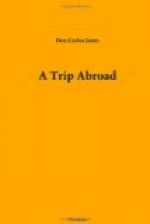The last place we visited before returning to Jerusalem was Ain Kairim, a town occupied mainly by the Mohammedans, and said to have been the home of that worthy couple of whom it was written: “They were both righteous before God, walking in all the commandments and ordinances of the Lord blameless” (Luke 1:6). The portion occupied by the Latins and Greeks is very beautifully situated on the side of the mountain. The stone houses, “whited walls,” and green cypresses make quite a pretty picture. The Church of St. John, according to tradition, stands on the spot where once dwelt Zacharias and Elizabeth, the parents of John, the great forerunner of Jesus. Night came upon us before we got back to our starting place, and as this was my first day of donkey riding, I was very much fatigued when I finally dismounted in Jerusalem; yet I arose the next morning feeling reasonably well, but not craving another donkey ride over a rough country beneath the hot sun.
On Saturday, the twenty-second of October, I turned away from Jerusalem, having been in and around the place almost two weeks, and went back to Jaffa by rail. After a few miles the railway leads past Bittir, supposed to be the Beth-arabah of Joshua 15:61. It is also of interest from the fact that it played a part in the famous insurrection of Bar Cochba against the Romans. In A.D. 135 it was captured by a Roman force after a siege of three and a half years. Ramleh, a point twelve miles from Jaffa, was once occupied by Napoleon. Lydda, supposed to be the Lod of Ezra 2:33, was passed. Here Peter healed Aeneas, who had been palsied eight years. (Acts 9:32-35.)
Jaffa is the Joppa of the Bible, and has a good deal of interesting history. When “Jonah rose to flee unto Tarshish from the presence of Jehovah,” he “went down to Joppa and found a ship going unto Tarshish: so he paid the fare thereof, and went down into it, to go with them to Tarshish from the presence of Jehovah.” (Jonah 1:3.) His unpleasant experience with the great fish is well known. When Solomon was about to build the first temple, Hiram sent a communication to him, saying: “We will cut wood out of Lebanon as much as thou shalt need; and will bring it to thee in floats by sea to Joppa; and thou shalt carry it up to Jerusalem” (2 Chron. 2:16). In the days of Ezra, when Zerubbabel repaired the temple, we read that “they gave money also unto the masons, and to the carpenters; and food, and drink, and oil, unto them of Sidon, and to them of Tyre, to bring cedar trees from Lebanon to the sea, unto Joppa, according to the grant that they had of Cyrus king of Persia” (Ezra 3:7). It was the home of “a certain disciple named Tabitha,” whom Peter was called from Lydda to raise from the dead. (Acts 9:36-43.) Simon the tanner also lived in Joppa, and it was at his house that Peter had his impressive vision of the sheet let down from heaven prior to his going to Caesarea to speak the word of salvation to Cornelius and his friends. (Acts 10:1-6.)




